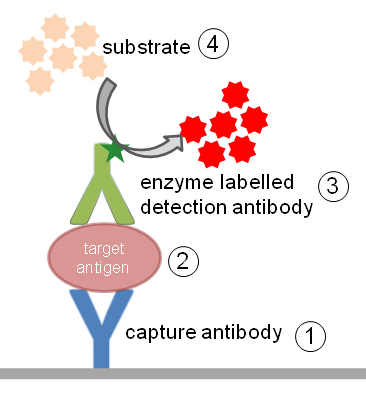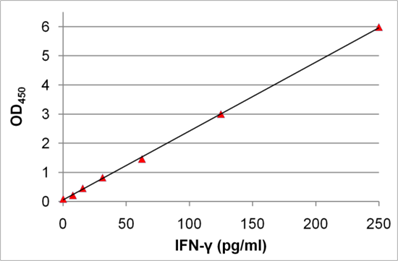BiteSized Immunology: Experimental Techniques

Enzyme-linked immunosorbent assay (ELISA)
The enzyme-linked immunosorbent assay (ELISA) is an immunological assay commonly used to measure antibodies, antigens, proteins and glycoproteins in biological samples. Some examples include: diagnosis of HIV infection, pregnancy tests, and measurement of cytokines or soluble receptors in cell supernatant or serum. ELISA assays are generally carried out in 96 well plates, allowing multiple samples to be measured in a single experiment. These plates need to be special absorbant plates (e.g. NUNC Immuno plates) to ensure the antibody or antigen sticks to the surface. Each ELISA measures a specific antigen, and kits for a variety of antigens are widely available.
The ELISA pictured in Figure 1 is what is known as a sandwich ELISA, here two sets of antibodies are used to detect secreted products, e.g. cytokines. The method is stepwise in the order shown. The 1st step is to coat the ELISA plate with capture antibody, any excess, unbound antibody is then washed from the plate. The capture antibody is an antibody raised against the antigen of interest.

Next the sample (e.g. urine, serum, or cell supernatant) is added. Any antigen found in the sample will bind to the capture antibody already coating the plate. Samples are usually added in duplicate or triplicate (to allow for statistical analysis), and in varying concentrations to guarantee it falls within the levels of detection of the assay. Again any excess sample is washed from the plate.
In step 3, detection antibody is added. This antibody is labelled with an enzyme, usually horse radish peroxidase or alkaline phosphatase. Detection antibody binds to any target antigen already bound to the plate. Finally, a substrate is added to the plate. ELISA assays are usually chromogenic using a reaction that converts the substrate (e.g. TMB or ABTS) into a coloured product which can be measured using a plate reader.
Determination of antigen concentration in a sample requires production of a standard curve using antigens of a known concentration (shown in Figure 2). The concentration of antigen in a sample can then be calculated using the optical density (OD).

© The copyright for this work resides with the author
